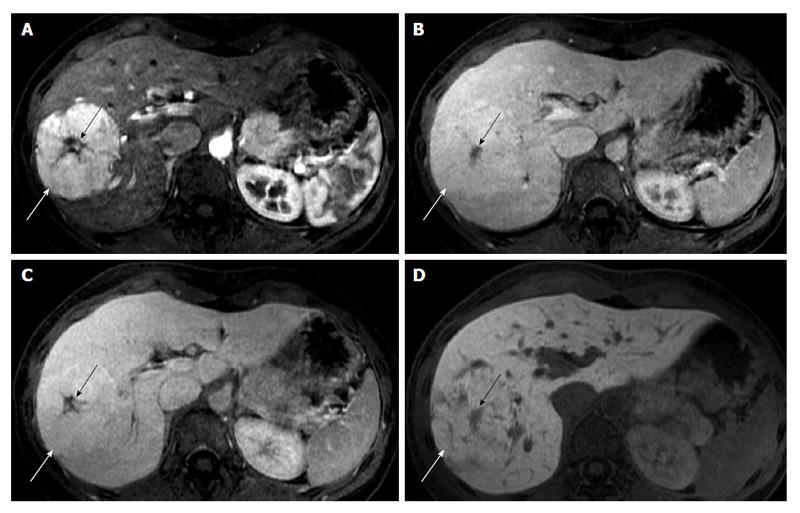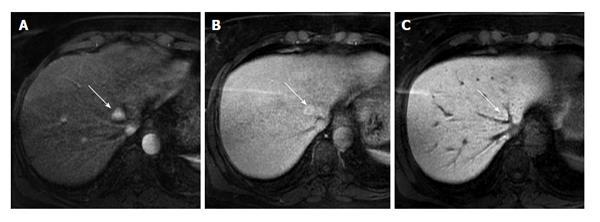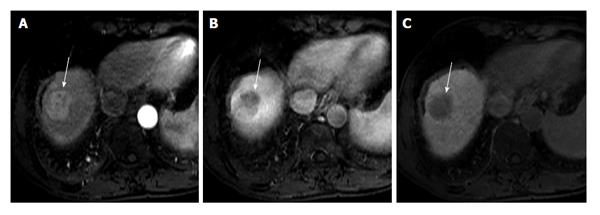Copyright
©2014 Baishideng Publishing Group Inc.
World J Hepatol. Jul 27, 2014; 6(7): 477-485
Published online Jul 27, 2014. doi: 10.4254/wjh.v6.i7.477
Published online Jul 27, 2014. doi: 10.4254/wjh.v6.i7.477
Figure 1 Typical imaging features of focal nodular hyperplasia in a 29-year-old woman.
Gadoxetic acid-enhanced magnetic resonance imaging; axial images (A-D) were obtained in dynamic phases and hepatobiliary phase. A shows a solid circumscribed mass (white arrow), lobulated in contour, with a central scar (black arrow); the lesion is hyperintense on the arterial phase (A) and persists slightly hyperintense in the portal and venous phases (B and C respectively). In hepatobiliary phase (D) the mass is slightly hyperintense or isointense to the surrounding liver. The presence of biliary canaliculi, even if not functioning, leads to retention of gadoxetic acid in comparison to the surrounding parenchyma.
Figure 2 Magnetic resonance imaging of a small focal nodular hyperplasia.
Arterial, venous and hepatobiliary phases (A, B and C), acquired in a 44-year-old woman shows the typical enhancement of a small focal nodular hyperplasia (white arrows). The lesion is located in the fourth liver segment, between medium and left sovrahepatic vein. In hepatobiliary phase (C) the lesion is slightly hyperintense to the surrounding liver parenchyma, due to uptake of hepatospecific contrast.
Figure 3 Imaging features of a typical hepatocellular carcinoma.
Axial magnetic resonance images show a hypervascular lesion in the arterial phase (A, white arrow), located in the top of the liver, with wash-out clearly in the portal venous phase (B, white arrow). This enhancement pattern represents the typical morphological hallmark of hepatocellular carcinoma. The nodule has an increased arteriolar supply and reduced portal vascularization. In hepatobiliary phase, the lesion appears hypointense to the surrounding liver parenchyma.
Figure 4 Imaging features of a small hepatocellular carcinoma.
The lesion (white arrow), located in the fifth segment of right hepatic lobe, is detectable in the arterial and hepatobiliary phase. It has hypervascular appearance in arterial phase (A), without evident wash-out in the portal phase (B). The lesion is hypointense in the hepatobiliary phase (C). As reported in literature, the low or absence of gadolinium ethoxybenzhyl diethylenetriaminepentaacetic acid or gadoxetic acid uptake could precede the decrease of portal vascularization in malignant differentiation.
- Citation: Palmucci S. Focal liver lesions detection and characterization: The advantages of gadoxetic acid-enhanced liver MRI. World J Hepatol 2014; 6(7): 477-485
- URL: https://www.wjgnet.com/1948-5182/full/v6/i7/477.htm
- DOI: https://dx.doi.org/10.4254/wjh.v6.i7.477












